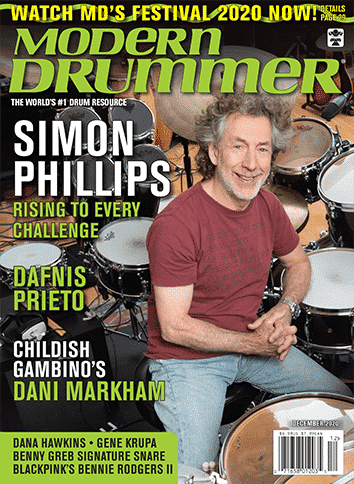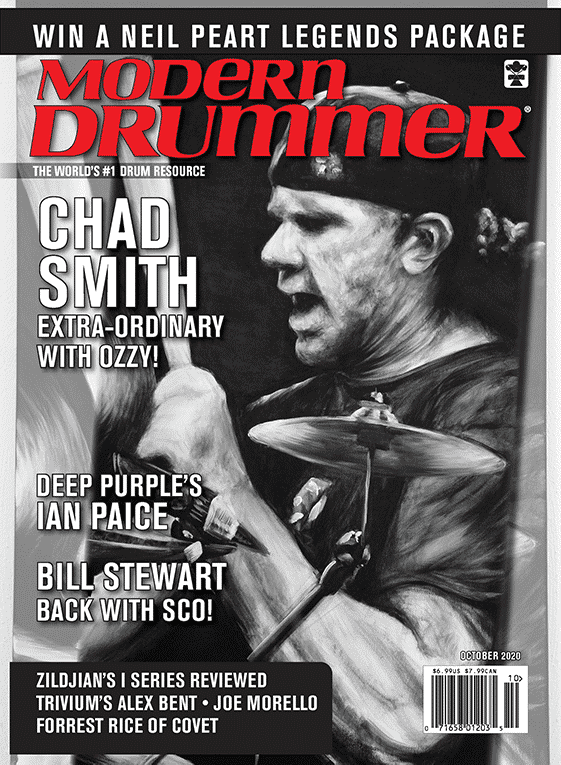Bill Bachman: Top 10 Rudiments Part 8: Flam Tap

The flam tap is on our list because it requires a unique hand motion where strokes decrescendo after an initial accent, without the stick stopping. Each hand plays an accent, tap, and grace note, in that order.
When going from an accent to a tap, we would usually play a downstroke in order to achieve the proper stick height and dynamic contrast. With the flam tap, however, at even a medium tempo there isn’t enough time to stop and then restart the stick’s motion at a lower height after the accent. With this in mind, we need to make each hand play rebounding strokes that decrescendo while maintaining the stick’s energy from the initial accent (no-chop flop-and-drop). The flam tap will train your hands to use this vital hand motion, which has built-in dynamics, flows well, and will be very useful for making music around the kit.
To play flam taps with maximum quality, let’s first take a look at the individual hand motion shown in Example 1. As written, each hand plays a high accent stroke followed by a low tap stroke and a grace note. (In the stickings, lowercase letters represent grace notes.) Usually the grace note is pushed ahead rhythmically, in order for it to precede the following hand’s accent. But in flam taps the strokes are straightened out into an even triple beat so that they flow smoothly. (The flams are created by placing the accents just behind the grace notes.) The technique used for the accent and the following tap falls somewhere between a full stroke and a downstroke, since the stick naturally drops down to a lower stick height and dynamic level while maintaining some rebound. The grace note will simply be an upstroke, in order to set the hand upward for the next accented triple beat. Advertisement
Playing flam taps should feel like you’re playing weak triple beats or simply letting the sticks bounce three times on the drumhead. Those with well-developed “alley-oopoop” finger control for playing strong triple beats (where all three beats are at roughly the same stick height and dynamic level) should pay particular attention, since strong inner beats will diminish the impact of the accents. The more you can exaggerate the contrast in stick height and dynamics, the better, since you’re emulating an accented flam and an unaccented tap. Much finesse will be necessary to play bouncy threes and flam taps with rhythmic accuracy. Here are quick tips for playing flam taps:
- Avoid hitting the accents extra hard with tight strokes, where the fingers are squeezing the stick when they should be playing the second and third beats of the triple beat.
- Avoid letting the accents bounce up high, leaving you unable to differentiate dynamically between the accent and the tap.
- Be sure to play the first stroke with a big accent from a high stick level. Don’t cheat the accent in the interest of playing the subsequent beats low.
To play flam taps at different speeds, you’ll need to modify your technique. At slower speeds, all of the strokes can be played easily using the wrists, with downstrokes on the accents for clear stick height and dynamic contrast. As you get to medium speeds and higher, you’ll need to start letting the stick bounce loosely from the accent to the second and third beats as explained above; otherwise the wrists will tighten up as they struggle to keep up with the tempo. When you practice this rudiment from slow to fast to slow over one minute, the change in technique should happen gradually as the tempo increases or decreases.



This article is culled from Bill Bachman’s popular Stick Technique book, which is designed to help players develop hands that are loose, stress free, and ready to play anything that comes to mind. The book is for everyone who plays with sticks, regardless of whether you’re focusing primarily on drumset, orchestral percussion, or the rudimental style of drumming. Divided into three main sections – Technique, Top-Ten Rudiments, and Chops Builders – Stick Technique is designed to get you playing essential techniques correctly and as quickly as possible. Also includes a bonus section two-hand coordination and independence. Advertisement






